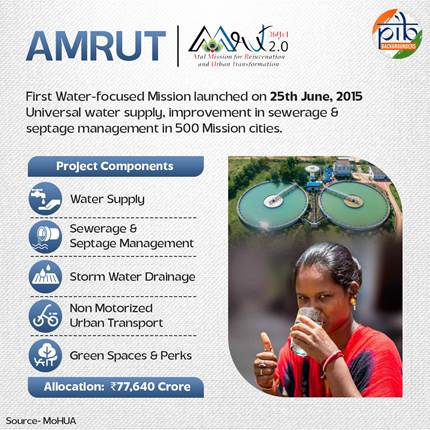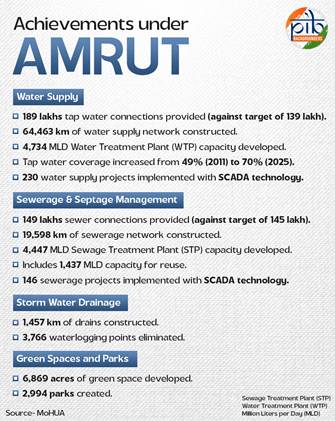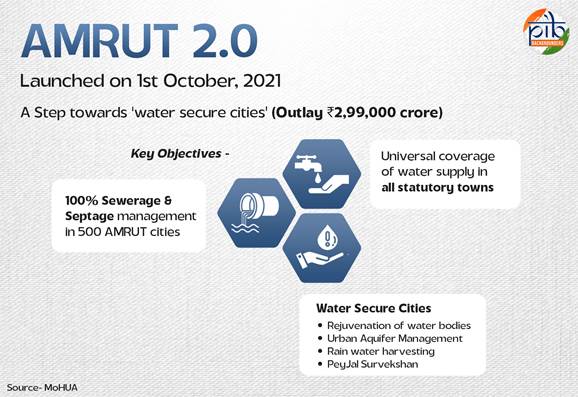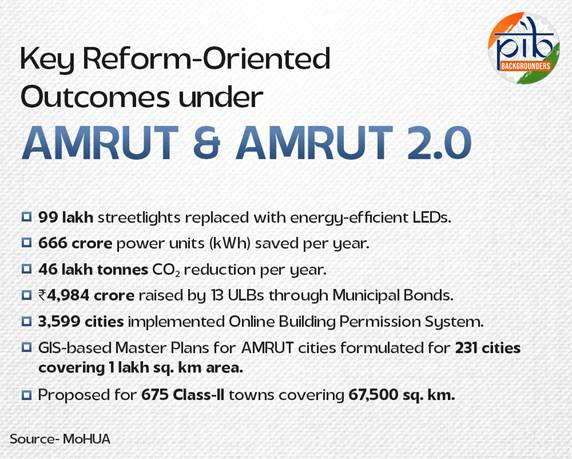Infrastructure
10 Years of AMRUT
Transforming Cities, Improving Lives
Posted On:
24 JUN 2025 2:29PM
|
Key takeaways
- Over the last 10 years, 2.03 crore tap connections and 1.50 crore sewer connections provided under AMRUT & AMRUT 2.0.
- ₹2.73 lakh crore worth of projects sanctioned; ₹1.12 lakh crore worth of works completed.
- 99 lakh LED streetlights installed, saving 666 crore kWh power and reducing 46 lakh tonnes of CO₂ annually.
- ₹4,984 crore raised by 13 ULBs through municipal bonds for urban infrastructure.
|
Introduction

India celebrates 10 years of the Atal Mission for Rejuvenation and Urban Transformation (AMRUT), a major initiative to improve the quality of life in cities. Launched on 25 June 2015, the Mission aimed to provide basic services such as water supply, sewerage, urban transport, and parks.
[1]It focused on building infrastructure that delivers better services to people, especially the poor. Water supply and sewerage were given top priority. Up to 2.5%[2] of the project cost was allowed for parks with features for children and the elderly.
The Mission covered 500 selected cities and towns (now 485 cities including 15 merged cities). It is a centrally sponsored scheme, with funds shared among States and UTs based on urban population and number of towns.
Under the Mission, State Annual Action Plans (SAAPs) worth ₹77,640 crore have been approved, including committed Central Assistance of ₹35,990 crore. So far, works worth ₹79,401 crore have been physically completed, and an expenditure of ₹72,656 crore has been incurred.
The purpose of the Atal Mission for Rejuvenation and Urban Transformation (AMRUT) is to
Ensure that every household has access to a tap with the assured supply of water and a sewerage connection.
Increase the amenity value of cities by developing greenery and well-maintained open spaces (e.g. parks) and
Reduce pollution by switching to public transport or constructing facilities for non-motorized transport (e.g. walking and cycling).
Benefits[3]
The components of AMRUT include capacity building, reform implementation, water supply, sewerage and septage management, storm water drainage, urban transport, and the development of green spaces and parks. Over the past 10 years, Urban Local Bodies (ULBs) have consistently strived to integrate smart features into physical infrastructure components during the planning and implementation process.
The details of the Mission components are given below.
Water Supply
Water supply systems including augmentation of existing water supply, water treatment plants and universal metering.
Rehabilitation of old water supply systems, including treatment plants.
Rejuvenation of water bodies specifically for drinking water supply and recharging of ground water.
Special water supply arrangement for difficult areas, hill and coastal cities, including those having water quality problems (e.g. arsenic, fluoride)
Sewerage
Decentralised, networked underground sewerage systems, including augmentation of existing sewerage systems and sewage treatment plants.
Rehabilitation of old sewerage system and treatment plants.
Recycling of water for beneficial purposes and reuse of wastewater.
Septage
Faecal Sludge Management- cleaning, transportation and treatment in a cost-effective manner.
Mechanical and biological cleaning of sewers and septic tanks and recovery of operational cost in full.
Storm Water Drainage
Construction and improvement of drains and storm water drains in order to reduce and eliminate flooding.
Urban Transport
Ferry vessels for inland waterways (excluding port/bay infrastructure) and buses.
Footpaths/walkways, sidewalks, foot over-bridges and facilities for non-motorised transport (e.g. bicycles).
Multi-level parking.
Bus Rapid Transit System (BRTS).
Green space and parks
Development of green space and parks with special provision for child-friendly components.
Capacity Building
This has two components- individual and institutional capacity building.
The capacity building will not be limited to the Mission Cities, but will be extended to other ULBs as well.
Continuation of the Comprehensive Capacity Building Programme (CCBP) after its realignment towards the new Missions.
Achievements under AMRUT
 [4]
[4]
AMRUT 2.0
AMRUT 2.0 was launched on 1 October 2021. It covers all Urban Local Bodies (ULBs) and aims to make cities water secure and self-reliant. One key goal is to provide universal coverage of sewerage and septage management in the original 500 AMRUT cities.The total indicative outlay for AMRUT 2.0 is ₹2,99,000 crore[5] including Central share of ₹76,760 crore for five years.

MoHUA also launched the "Jal Hi AMRIT" initiative under AMRUT 2.0. It encourages states and UTs to manage sewage plants efficiently. The aim is to treat and reuse water safely, helping to improve water availability and support water security.
Achievements under AMRUT 2.0[6]
1. Water Supply
- 3,568 water supply projects worth ₹1,14,220.62 crore approved.
- 181 lakh new tap connections approved.
- 10,647 MLD Water Treatment Plant (WTP) capacity approved.
- 1,487 water supply projects approved with SCADA technology.
2. Sewerage & Septage Management
- 592 sewerage/septage management projects worth ₹67,607.67 crore approved (includes O&M cost).
- 67.11 lakh new sewer connections approved.
- 6,739 MLD Sewage Treatment Plant (STP) capacity approved.
- 235 sewerage projects approved withSupervisory Control and Data Acquisition(SCADA) technology.
Additional Innovation Component
Technology Sub-Missionis another component of AMRUT 2.0 to encourage start-up ideas and private entrepreneurship.
-
- 120 start-ups shortlisted.
- Mapped to 82 AMRUT cities for pilot projects.
Overall Achievements of AMRUT & AMRUT 2.0 (Last 10 Years)
Physical Progress
- 14,828 projects costing ₹2,73,649 crore sanctioned under AMRUT & AMRUT 2.0.
- Overall works worth around ₹1,12,368 crore physically completed.
Financial Progress
- ₹3,77,000 crore total outlay.
- ₹1,02,786 crore Central Assistance (CA) allocated for projects.
- ₹97,963 crore expended on projects by Centre/States & Urban Local Bodies (ULBs).
- ₹47,625 crore CA released for projects.
Major Outcomes Achieved (Projects)
- 2.03 crore tap connections and 1.50 crore sewer connections provided.
- 544 water bodies rejuvenated, covering 9,511 acres.

Other Initiatives
- ‘AMRUT Mitra’ involved 10,000+ women Self-Help Group (SHG) members.1,762 projects worth ₹147 crore approved.
- Drink from Tap (DFT) through 381 projects worth ₹23,490 crore sanctioned, likely to benefit 8 lakh households.3,630 contractors/officials trained.
- 3,032 water bodies approved for rejuvenation, covering 1.09 lakh acre area.
- Capacities of States augmented by training over 90,000 contractors, plant operators, plumbers, women, youth, officials etc.
Conclusion:
As AMRUT completes a decade, it marks a significant shift in India’s urban development approach, focused on inclusive planning, efficient service delivery, and sustainable growth. By strengthening local bodies and improving core services like water, sanitation, and green spaces, the Mission has laid a strong foundation for future-ready, liveable cities across the country.
References:
Ministry of Housing and Urban Affairs (MoHUA)
Click here to see in PDF
Santosh Kumar/Abhishek K SAnchalPatiyal
(Backgrounder ID: 154737)
Visitor Counter : 10546
Provide suggestions / comments